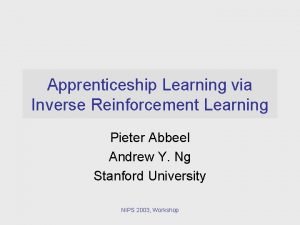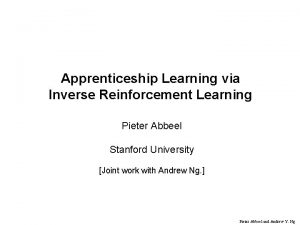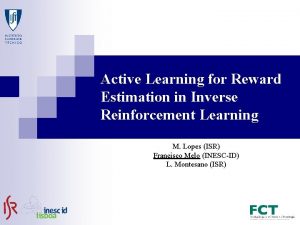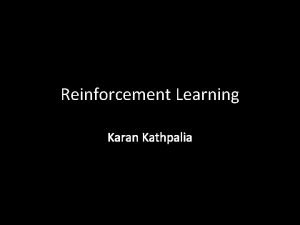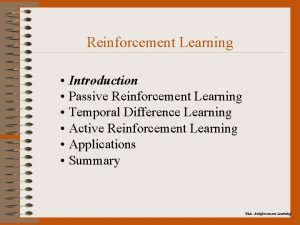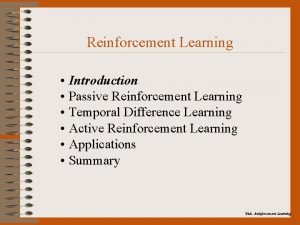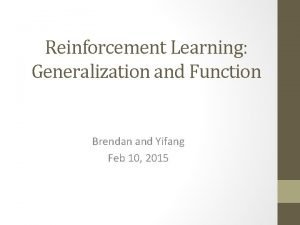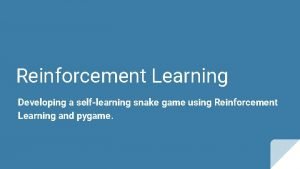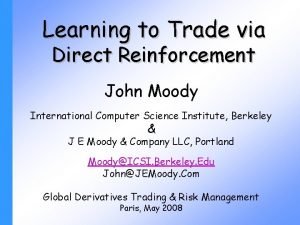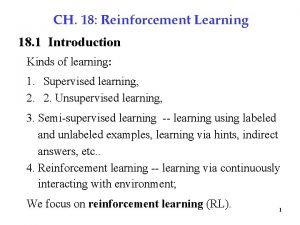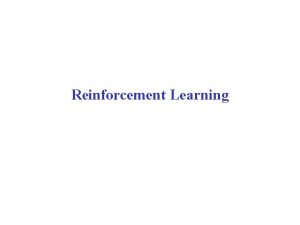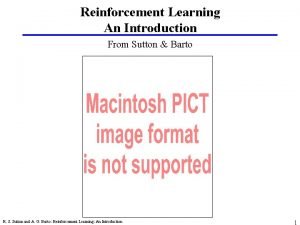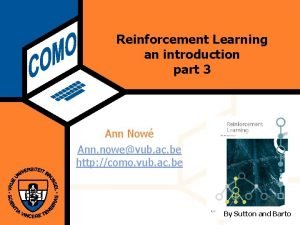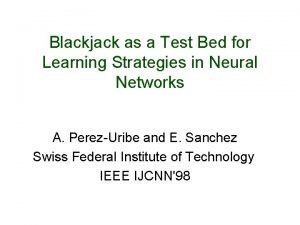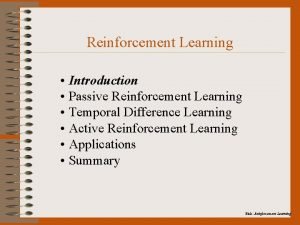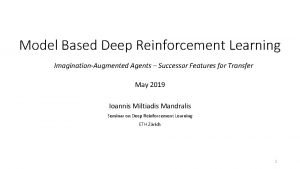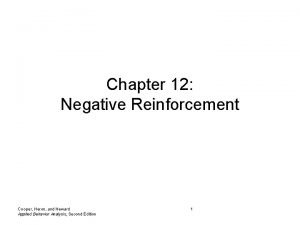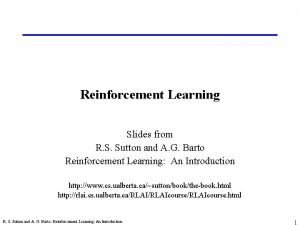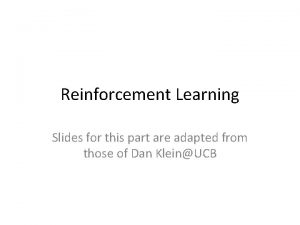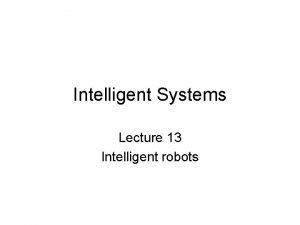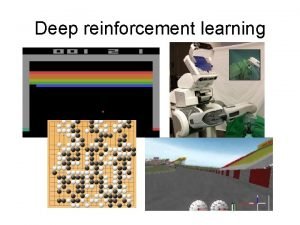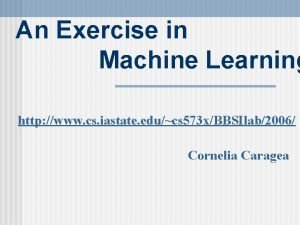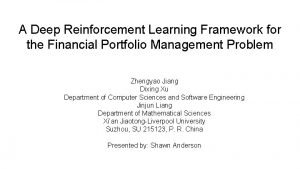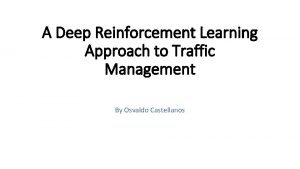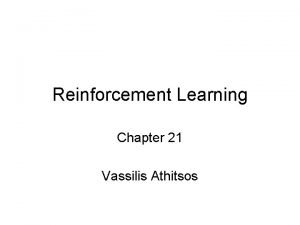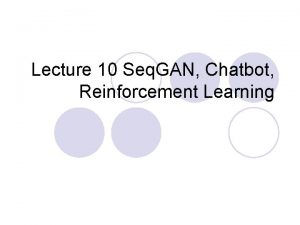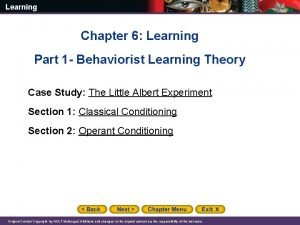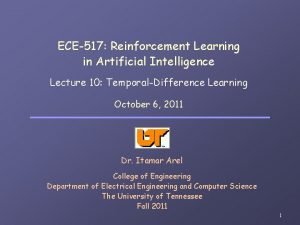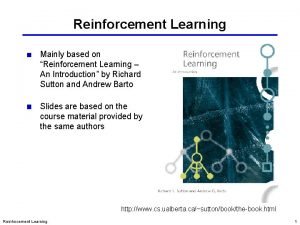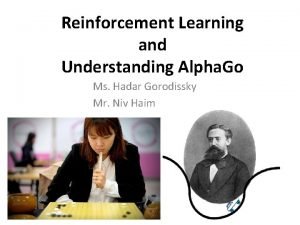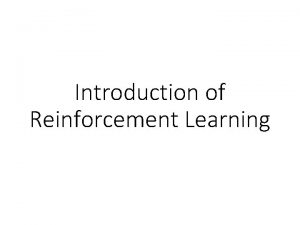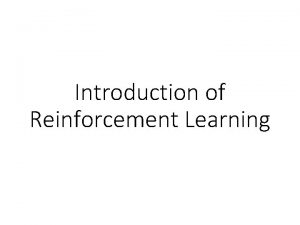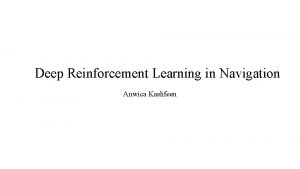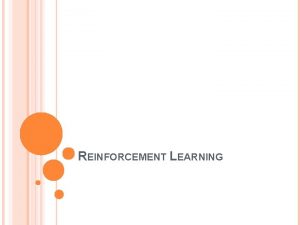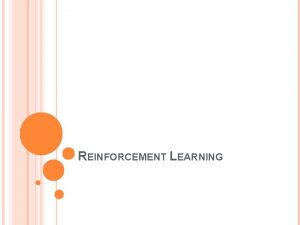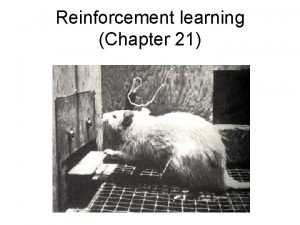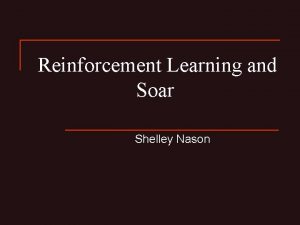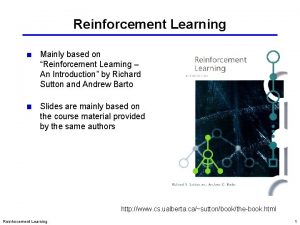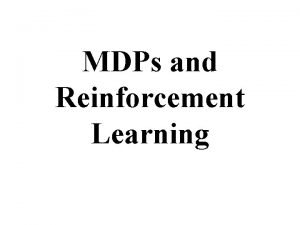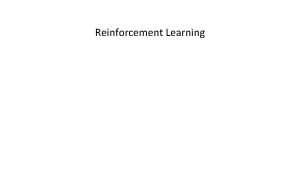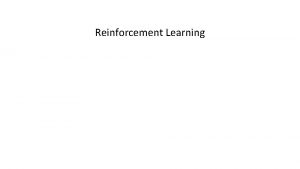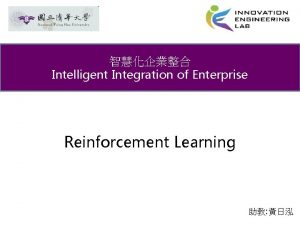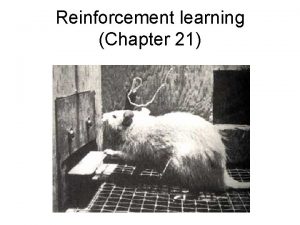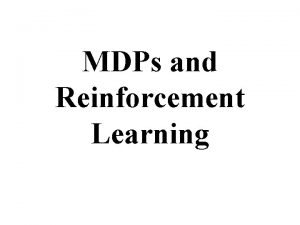A Deep Reinforcement Learning Framework for the Financial










































![References [1] coinmarketcap https: //coinmarketcap. com/ [2] https: //www. buybitcoinworldwide. com/price/ [3] Poloniex https: References [1] coinmarketcap https: //coinmarketcap. com/ [2] https: //www. buybitcoinworldwide. com/price/ [3] Poloniex https:](https://slidetodoc.com/presentation_image_h/26fd64139515e10de282857c74758b8f/image-43.jpg)
- Slides: 43

A Deep Reinforcement Learning Framework for the Financial Portfolio Management Problem Zhengyao Jiang Dixing Xu Department of Computer Sciences and Software Engineering Jinjun Liang Department of Mathematical Sciences Xi’an Jiaotong-Liverpool University Suzhou, SU 215123, P. R. China Presented by: Shawn Anderson

Can we build a machine to trade our Bitcoin for us? ! ● Cryptocurrency prices are unprecedented. ● The Market cap is now over 450 Billion Dollars [1] https: //coinmarketcap. com/gainers-losers/ 2

Yes we can! The Price Tensor Xt The Portfolio Vector wt Wt-1 Deep Reinforcement Learning 3

Outline ● Cryptocurrencies and Markets ● The Portfolio Management Problem ● Reinforcement Learning as a Portfolio Manager ● Mini-machine Network Topology ● Results and Future Work 4

Outline ● Cryptocurrencies and Markets ● The Portfolio Management Problem ● Reinforcement Learning as a Portfolio Manager ● Mini-machine Network Topology ● Results and Future Work 5

Cryptocurrencies and Markets ● Cryptocurrencies are tradeable, digital assets that can represent value and be traded on an open market. ● Cryptocurrency exchanges are websites that serve as open marketplaces where users can trade cryptocurrencies for other cryptocurrencies or fiat currencies. 6

What is Cryptocurrency? ● January 3 rd 2009 First Bitcoins mined by Satoshi Nakamoto ● Bitcoin is a public ledger ● There will only ever be 21 million Bitcoin, creating scarcity ● Now there are over 1000 ‘altcoins’ ● Cryptocurrencies are referred to as ‘coins’ Bitcoin Price 2011 -2018 Price of one Bitcoin in USD from 2011 -2018. Blue: Price, Black: Log Price [2] https: //www. buybitcoinworldwide. com/price/ 7

Why Cryptocurrency Markets? poloniex. com ● Open 24/7 ● Free API access to trading and data ● High price movement and volatility ● Decentralization and Openness A gif of the ‘Markets’ view on poloniex. com, A Cryptocurrency Exchange [3] poloniex. com 8

Market Assumptions and Asset Selection 1. Zero Slippage If we see a trade, then we can execute it. Poloniex Trade Pairs by Volume 1. Zero Market Impact Our buys and sells do not effect market prices. Poloniex Trade Pairs Ranked by Trade Volume (Top 4) [3] https: //coinmarketcap. com/exchanges/poloniex/ 9

Outline ● Cryptocurrencies and Markets ● The Portfolio Management Problem ● Reinforcement Learning as a Portfolio Manager ● Mini-machine Network Topology ● Results and Future Work 10

The Portfolio Management Problem ● Given a portfolio of assets, periodically redistribute the portfolio in order to maximize gains over each period. 11

m: Number of Assets T: Length of time period t: Time step counter Managing Our Portfolio Assets wt-1 vt-1 Price Vector 50% 1 40% 10% vt wt+1 30% 1 35% 1 0. 5 50% 0. 4 40% 0. 8 0. 3 20% 0. 6 25% 0. 7 wt vt+1 Portfolio Vector wt: Portfolio Vector vt: Price Vector 12

The Relative Price Vector wt-1 vt-1 50% 1 40% 10% vt wt+1 30% 1 35% 1 0. 5 50% 0. 4 40% 0. 8 0. 3 20% 0. 6 25% 0. 7 wt yt+1 yt 1 vt+1 Relative Price Vector 1 0. 8 2 2 1. 17 wt: Portfolio Vector vt: Price Vector yt: Relative Price Vector 13

The Rate of Return wt-1 wt wt+1 50% 35% 40% 50% 40% 10% 25% yt �t 0. 02 Rate of Return yt+1 1 1 0. 8 2 2 1. 17 �t 0. 534 wt: Portfolio Vector yt: Relative Price Vector �t: Rate of Return 14

The Portfolio Value wt-1 wt wt+1 50% 35% 40% 50% 40% 10% 25% yt Portfolio Value pt-1 $10. 00 �t 0. 02 yt+1 1 1 0. 8 2 2 1. 17 pt $10. 20 �t 0. 534 pt +1 $15. 65 wt: Portfolio Vector yt: Relative Price Vector �t: Rate of Return pt: Portfolio Value 15

Logarithmic Rate of Return wt-1 wt wt+1 50% 35% 40% 50% 40% 10% 25% yt pt-1 $10. 00 rt 0. 02 Log Rate of Return yt+1 1 1 0. 8 2 2 1. 17 pt $10. 20 rt 0. 43 pt +1 $15. 65 wt: Portfolio Vector yt: Relative Price Vector rt: Log Rate of Return pt: Portfolio Value 16

Maximize Final Portfolio Value wt-1 wt wt+1 50% 35% 40% 50% 40% 10% 25% yt pt-1 $10. 00 rt 0. 02 yt+1 1 1 0. 8 2 2 1. 17 pt $10. 20 rt 0. 43 pt +1 $15. 65 wt: Portfolio Vector yt: Relative Price Vector rt: Log Rate of Return pt: Portfolio Value 17

Outline ● Cryptocurrencies and Markets ● The Portfolio Management Problem ● Reinforcement Learning as a Portfolio Manager ● Mini-machine Network Topology ● Results and Future Work 18

System Overview The Price Tensor Xt The Portfolio Vector wt Wt-1 Deep Reinforcement Learning 19

Reinforcement Learning as a Portfolio Manager Agent rt wt-1 wt Environment wt: Portfolio Vector Xt: Price Tensor rt: Rate of Return 20 [3] Silver, David. Retrieved from: http: //www 0. cs. ucl. ac. uk/staff/d. silver/web/Teaching_files/intro_RL. pdf

The Price Tensor wt v(lo)t-50 v(lo)t-49 1 0. 5 1. 8 0. 7 0. 6 v(lo)t-2 v(lo)t-1 0. 7 1. 1 v(hi)t-50 v(hi)t-49 1. 2 1. 4 0. 6 2. 1 1. 10. 7 0. 6 1. 1 1. 4 f number of features 31% v(hi)t-2 v(hi)t-1 26% 0. 9 1. 1 vt-50 vt-49 1 1. 1 0. 7 0. 8 0. 9 0. 6 1. 1 0. 6 1 2 1. 4 1. 1 vt-2 vt-1 41% 0. 9 0. 7 1. 1 n historic periods 1. 1 0. 9 1 m number of non-cash assets 2% wt: Portfolio Vector Xt: Price Tensor rt: Rate of Return 21

Full Exploitation and the Reward Function ● Reward function is explicitly expressed ○ Actions do not impact the environment ● All episodic rewards are equally important ● Reward Function: wt: Portfolio Vector Xt: Price Tensor rt: Rate of Return 22

Deterministic Policy Gradient ● Action is deterministically produced by the policy, given a state ● State st = (Xt, wt-1) ● Action at = wt = πθ(st) ● Objective Function: wt: Portfolio Vector Xt: Price Tensor rt: Rate of Return 23

Policy Networks ● The policy network πθ will be constructed using three different deep Neural Networks, CNN, RNN, and LSTM. ● Gradient Ascent Update: 24

Outline ● Cryptocurrencies and Markets ● The Portfolio Management Problem ● Reinforcement Learning as a Portfolio Manager ● Mini-machine Network Topology ● Results and Future Work 25

Mini-machine Topology ● The nicknamed ‘Mini-machine Topology’ is the combination of three technical achievements made by the authors: ○ Ensemble of Independent Identical Evaluators (EIIE) ○ Portfolio Vector Memory (PVM) ○ Online Stochastic Batch Learning (OSBL) 26

Ensemble of Identical Independent Evaluators (EIIE) ● Input: Price Tensor Xt, Previous portfolio vector wt-1 ● Networks flow independently for each asset, while parameters are shared. ● Softmax Layer: Non-negative and sums to unity 27

Ensemble of Identical Independent Evaluators (EIIE) ● Input: Price Tensor Xt, Previous portfolio vector wt-1 ● Networks flow independently for each asset, while parameters are shared. ● Softmax Layer: Non-negative and sums to unity Price Tensor 48 x 2 hidden layer Portfolio Value of Coin From Wt-1 Squashed By Softmax f features Coin Evaluation n periods 3 x 2 Conv 48 x 2 Conv (x 20) Wt Coin Value 21 x 1 hidden layer 28

RNN Implementation ● EIIE Component can be swapped out for RNN or LSTM 29

Portfolio Vector Memory (PVM) ● To maintain a full record of state history, we require all historic portfolio vectors ● State st = (Xt, wt-1) 30

Online Stochastic Batch Learning (OSBL) ● We can train on historic data while managing our portfolio in real time! Our batch sample distribution: 0 8 Our batch gradient update: ● nb: Size of batches ● tb: Randomly selected training period ● �� : Probability Decay rate 1 2 9 t = 15 3 10 11 P�� =0. 5(tb), nb = 3: 4 12 5 13 14 6 15 %3. 13 %6. 25 %13 %25 0 7 %50 0 0 31

Mini-machine Topology ● This structure allows for incredible performance, few network parameters, linear scaling in number of coins, a convergence of historic portfolio vectors, and efficient online training. 32

Outline ● Cryptocurrencies and Markets ● The Portfolio Management Problem ● Reinforcement Learning as a Portfolio Manager ● Mini-machine Topology ● Results and Future Work 33

Experiments ● Cross Validation for hyper parameter tuning ● 3 Back-Tests to cover different market conditions Data Purpose Train (675 days ~ 22 mos) Test (50 days) Cross Validation Jul 2014 - May 2016 - June 2016 Back-Test 1 Nov 2014 - Sep 2016 Sept 2016 - Oct 2017 Back-Test 2 Feb 2015 - Dec 2016 - Jan 2017 Back-Test 3 May 2015 - March 2017 - April 2017 34

Performance Measures ● Accumulative Portfolio Value (f. APV) - Higher is better ● Sharpe Ratio (SR) - Higher is better ● Maximum Drawdown (MDD) - Lower is better 35

Results ● Mini-machine topology dominates f. APV and SR in all three Back-tests ● RNN grows Portfolio 47 times in 50 days in Back-test 3! Back-Test 1 Back-Test 3 Back-Test 2 Work by the Authors Benchmarks 36

Back Test 1 - Moderate Market Conditions Sept 2016 - Oct 2017 37

Back Test 2 - Poor Market Conditions Dec 2016 - Jan 2017 38

Back Test 3 - Favourable Market Conditions March 2017 - April 2017 39

Conclusion ● Cryptocurrency markets offer an exciting playground for modern financial strategy exploration ● Deterministic Policy Deep Reinforcement Learning offers very promising results in Portfolio Management ● Mini-machine topology allows for strong returns, efficient scaling to more coins, and online learning. 40

Future Work ● ● ● ● Forward Testing Longer Trading Periods Relaxed Assumptions ○ Zero market impact (Deterministic Policy -> Stochastic / Value based) ○ Zero slippage (For Forward Testing) Architecture Experimentation More Price Tensor Features ○ Order book data, volume data ○ External data (Social media, web scraping) Multi-Agent System ○ Distributed parameter search ○ Inter-agent trading (zero fees!) More Assets / More Markets (Stock market) 41

Thank you! Check out the software! PGPortfolio on Git. Hub: https: //github. com/Zhengyao. Jiang/PGPortfolio 42
![References 1 coinmarketcap https coinmarketcap com 2 https www buybitcoinworldwide comprice 3 Poloniex https References [1] coinmarketcap https: //coinmarketcap. com/ [2] https: //www. buybitcoinworldwide. com/price/ [3] Poloniex https:](https://slidetodoc.com/presentation_image_h/26fd64139515e10de282857c74758b8f/image-43.jpg)
References [1] coinmarketcap https: //coinmarketcap. com/ [2] https: //www. buybitcoinworldwide. com/price/ [3] Poloniex https: //poloniex. com/ [4] Deep. RL for the FPMP https: //arxiv. org/pdf/1706. 10059. pdf [5] Reinforcement Learning And Introduction. Richard S. Sutton and Andrew G. Bartohttp: //incompleteideas. net/bookdraft 2018 jan 1. pdf [6] Deep Reinforcement Learning. David Silver. http: //www 0. cs. ucl. ac. uk/staff/d. silver/web/Teaching. html [7] D Charles, II Kirkpatrick, and Julie R Dahlquist. Technical analysis: The complete resource for financial market technician. ISBN-13, pages 978– 0137059447, 2006. 43
 Wsbgixdc9g8 -site:youtube.com
Wsbgixdc9g8 -site:youtube.com Lda supervised or unsupervised
Lda supervised or unsupervised Apprenticeship learning via inverse reinforcement learning
Apprenticeship learning via inverse reinforcement learning Apprenticeship learning via inverse reinforcement learning
Apprenticeship learning via inverse reinforcement learning Active learning reinforcement learning
Active learning reinforcement learning Sexondary reinforcer
Sexondary reinforcer Cmu machine learning
Cmu machine learning Deep learning approach and surface learning approach
Deep learning approach and surface learning approach Deep asleep deep asleep it lies
Deep asleep deep asleep it lies Deep forest: towards an alternative to deep neural networks
Deep forest: towards an alternative to deep neural networks O the deep deep love of jesus
O the deep deep love of jesus Cuadro comparativo e-learning b-learning m-learning
Cuadro comparativo e-learning b-learning m-learning What is optimal policy in reinforcement learning
What is optimal policy in reinforcement learning Passive reinforcement learning example
Passive reinforcement learning example What is active and passive reinforcement learning
What is active and passive reinforcement learning Coarse coding reinforcement learning
Coarse coding reinforcement learning Snake game reinforcement learning
Snake game reinforcement learning Learning to trade via direct reinforcement
Learning to trade via direct reinforcement Hierarchical reinforcement learning: a comprehensive survey
Hierarchical reinforcement learning: a comprehensive survey What is optimal policy in reinforcement learning
What is optimal policy in reinforcement learning Q learning exploration vs exploitation
Q learning exploration vs exploitation Sutton blackjack
Sutton blackjack Jack's car rental reinforcement learning
Jack's car rental reinforcement learning Blackjack reinforcement learning
Blackjack reinforcement learning Passive reinforcement learning
Passive reinforcement learning I2a reinforcement learning
I2a reinforcement learning Socially mediated negative reinforcement
Socially mediated negative reinforcement Reinforcement learning slides
Reinforcement learning slides Reinforcement learning slides
Reinforcement learning slides Reinforcement learning agent environment
Reinforcement learning agent environment Alpha go zero
Alpha go zero Reinforcement learning exercises
Reinforcement learning exercises Policy network reinforcement learning
Policy network reinforcement learning A long peek into reinforcement learning
A long peek into reinforcement learning Using inaccurate models in reinforcement learning
Using inaccurate models in reinforcement learning Reinforcement learning lectures
Reinforcement learning lectures Vassilis athitsos
Vassilis athitsos Gan chatbot
Gan chatbot Reinforcement learning behaviorism
Reinforcement learning behaviorism Reinforcement learning lectures
Reinforcement learning lectures Passive reinforcement learning in artificial intelligence
Passive reinforcement learning in artificial intelligence Td(0)
Td(0) Alpha reinforcement learning
Alpha reinforcement learning Reinforcement learning mooc
Reinforcement learning mooc


